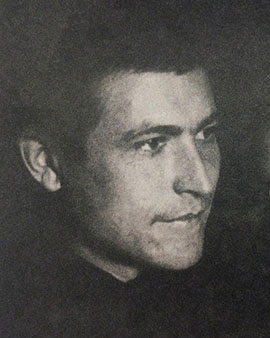


Gustavs Klucis, an emblematic figure of the early 20th-century Constructivist avant-garde, made his name primarily through his Soviet Revolutionary and later Stalinist propaganda. Klucis, born January 16, 1895, near Rūjiena, Latvia, set standards with his artful photomontages, often created in collaboration with his wife and collaborator Valentina Kulagina. His artful images, created through the fusion of photography and political messages, offered viewers a distorted perspective on reality and are reproduced today in our collection of fine art prints.
In 1912, Klucis began his artistic journey in Riga, which took him through a multi-faceted education, service in the Russian army, and eventually to Moscow. Here he met his future wife and partner Kulagina in 1918, studied art under the greats Kazimir Severinovich Malevich and Anton Pewsner, and joined the Communist Party. His commitment to political art was profound, he created it, taught it and wrote about it. This close connection between art and politics is reflected in our art prints, which emulate Klucis' intense and influential style.
In the 1920s and 1930s, when Stalinism and the "purges" were at their height, Klucis and Kulagina came under increasing pressure to limit their subject matter and techniques. Their work, originally revolutionary and utopian, became a supporting instrument of Stalin's personality cult by 1935. Despite his loyal service to the party, Klucis was arrested on January 17, 1938, and executed shortly thereafter. Despite the tragic end to his life story, Gustavs Klucis remains a fascinating example of the influence of art on society and politics. In reproducing his works as art prints, we honor his artistic vision and legacy. Through his depiction of revolutionary themes and his distinctive use of photomontage, his works remind us how art can be used as a powerful medium to represent and influence the world.

Gustavs Klucis, an emblematic figure of the early 20th-century Constructivist avant-garde, made his name primarily through his Soviet Revolutionary and later Stalinist propaganda. Klucis, born January 16, 1895, near Rūjiena, Latvia, set standards with his artful photomontages, often created in collaboration with his wife and collaborator Valentina Kulagina. His artful images, created through the fusion of photography and political messages, offered viewers a distorted perspective on reality and are reproduced today in our collection of fine art prints.
In 1912, Klucis began his artistic journey in Riga, which took him through a multi-faceted education, service in the Russian army, and eventually to Moscow. Here he met his future wife and partner Kulagina in 1918, studied art under the greats Kazimir Severinovich Malevich and Anton Pewsner, and joined the Communist Party. His commitment to political art was profound, he created it, taught it and wrote about it. This close connection between art and politics is reflected in our art prints, which emulate Klucis' intense and influential style.
In the 1920s and 1930s, when Stalinism and the "purges" were at their height, Klucis and Kulagina came under increasing pressure to limit their subject matter and techniques. Their work, originally revolutionary and utopian, became a supporting instrument of Stalin's personality cult by 1935. Despite his loyal service to the party, Klucis was arrested on January 17, 1938, and executed shortly thereafter. Despite the tragic end to his life story, Gustavs Klucis remains a fascinating example of the influence of art on society and politics. In reproducing his works as art prints, we honor his artistic vision and legacy. Through his depiction of revolutionary themes and his distinctive use of photomontage, his works remind us how art can be used as a powerful medium to represent and influence the world.
Page 1 / 1






